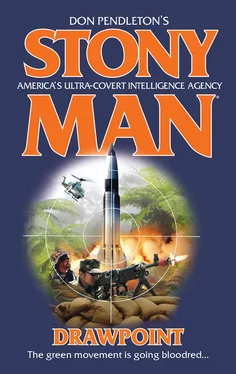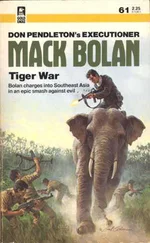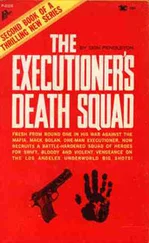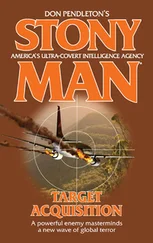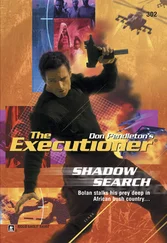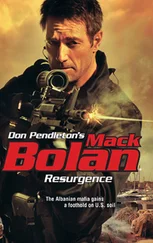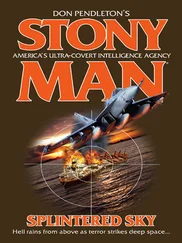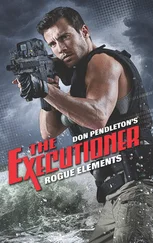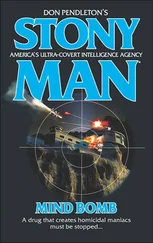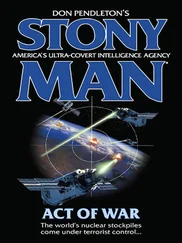“We’re going to get shot at,” Hawkins said.
“I’m counting on it,” McCarter grinned. “Gary, be ready.”
“On it,” Manning called back.
The two Phoenix Force commandos, slightly crouched, moved from one piece of equipment to the next, closing in on the large main building that was the central point in the cement plant. McCarter was playing a dangerous game, he knew, but tripping a deadfall was never easy. They would have to strike a delicate balance, staying out of the enemy’s direct lines of fire while nonetheless making themselves tempting targets. He paused near some kind of grinder, the mammoth machine showing spots of rust under peeling paint as it hulked in the humid climate.
The Briton caught movement in the corner of his eye and knew that the moment had come. The muzzle-flash, when it appeared in a window on the second story of the main building, was brief but plainly visible. Dirt churned near Hawkins’s feet as a trio of bullets dug into the ground. The answering thunder from Manning’s M-24 came half a beat later. One down.
McCarter and Hawkins ran for it, opening up with their Tavors. The chatter of the lightweight Israeli guns was met by the characteristic hollow racket of Kalashnikovs. The Phoenix Force leader, even as he moved, noted the positions of the enemy fire—and smiled with grim satisfaction. Almost lost in the chaotic din was the slow, deadly drumbeat of Manning and his sniper-tuned Remington 700, but wherever his answering call went, the muzzle-flashes marking the enemy suddenly ceased. By the time McCarter and Hawkins made the entrance of the big building, the Briton was confident most of the shooters were down.
Hawkins took the left and McCarter the right as they cleared the doorway. A pair of dark-skinned men wearing mismatched jungle camouflage and black bandanna face masks opened fire on them. The Tavors barked and the first man, then the next fell. Two more Kalashnikovs fell silent.
“Take the ground floor, T.J.,” McCarter directed, confident his earbud would carry the words to Hawkins. “I’ll take the high road.” The structure was basically a corrugated metal warehouse boasting a single large, open factory floor. Heavy equipment, for grinding and mixing, was clustered in the middle at ground level. A metal catwalk ran the perimeter of the building’s interior, and it was from there that the gunmen had been firing. McCarter scaled the nearest ladder and hoisted himself up onto the rickety, rusting framework, scanning for targets among the fallen bodies of the shooters.
“Anything, T.J.?” McCarter asked.
“No one left on this level at the front,” Hawkins reported.
“No one at the rear,” James said, unseen somewhere on the other side of the building. “We took out one gunner. All’s quiet.”
“All right,” McCarter said. “Search the bodies. See if you can find anything useful. I’ll make the rounds up here and then join you on the ground. Gary?”
“On my way back to the truck to check Gopalan,” the big Canadian’s voice came back.
“Good,” McCarter said. “Not such a bad plan, now, was it?”
Manning grumbled something over the link. McCarter resisted the urge to laugh.
He checked each man in turn. The shooters carried guns and some ammunition, but nothing else—no identification, no clues, and no other personal effects. McCarter took a picture of each corpse with the camera built into his secure wireless phone. The other Phoenix Force members would be doing the same, he knew. The pictures would be sent to the Farm to see if an identification, and hence any records, could be pulled from across the vast computer networks to which Stony Man had access.
He was toeing over the last of the bodies when the man lying on the rusty catwalk opened his eyes.
The man screamed something and surged to his feet, a Kalashnikov bayonet flashing in his hand. McCarter leaned back in time to avoid the small bowie-shaped blade slashing at his gut, but the man lunged after him, and McCarter stumbled. The Tavor fell from his hands as the man tackled him. They rolled, coming up again, and the man charged with the blade before McCarter could take the initiative. The Briton had just enough to time to slap his hands down, knocking the knife aside, as he stepped in to slam the palm of his off hand up and under the man’s chin.
The blow rocked the knifer onto his back. He rolled and came up again, shaking his head, his whole body trembling. McCarter saw the look of a true believer in his eyes, an expression he’d seen on many a fanatic and terrorist. The man came in again, close behind his knife, seeking McCarter’s flesh with the needle-sharp clip point.
The Browning Hi-Power filled the Briton’s hand.
“Drop the blade,” McCarter ordered.
The knifer remained steady and focused.
“Look, mate,” he said, trying to sound calm. “it’s over. We don’t want to kill you. We want to question you. Play it right and you could walk away from this.” While that last was, strictly speaking, a lie, McCarter needed the guy alive. There were too many questions to be answered, and they had about all they were likely to get from Gopalan. Something was afoot, something big, and if the Stony Man teams were to get to the bottom of it, they needed to start producing more answers than questions.
The man lunged.
McCarter swore and fired, putting a single round between the man’s eyes. There was no other choice; if he tried to play fancy trick-shooting games with a charging blade, it could mean his life. The would-be killer was dead before his body completed its fall to the catwalk, the knife clanging on the rusty metal.
“Bloody hell,” McCarter said once more.
The apartment building was as decrepit a structure as any the members of Able Team were likely to find in the area. Looking around, Carl Lyons shook his head. The buildings here had a sense of history. It was obvious this had once been a much better neighborhood. Now it was dying, rotting from the inside out, a victim of the animals who lived there and preyed on one another. Able Team had visited many such places in their battle against terror and crime. Still, even a hardened former cop and veteran counterterrorist like Lyons felt a pang of regret whenever he saw a place like this one, so badly gone to seed.
They were dressed casually. Lyons wore a bomber jacket over denims, while Blancanales and Gadgets wore slacks, polo shirts and windbreakers. Their nondescript attire did nothing to conceal the weapons in their hands. Lyons would normally have moved much more discreetly, but they had received a scrambled call from the Farm only minutes before reaching their destination that morning. Phoenix Force had taken down an ambush in India, and no one knew precisely how the enemy was a step ahead of what the Stony Man teams were doing. Given that, the former L.A. detective didn’t intend to get blindsided. They were going in, yes, and they were going in hot.
The target was an apartment building, and specifically a unit on its top floor. The site was part of the list produced by the Farm’s computer wizards. Each target on the priority-ordered list was linked to a person or persons of interest relevant to the WWUP or the ecoterror groups funding them, as Kurtzman had explained it. The fundamental mission had not changed. Both Able Team and Phoenix Force were shaking trees to see what fell out of them.
These trees, of course, often bore lethal fruit.
The shotgun Carl Lyons held in his calloused fists was a Daewoo USAS-12, a massive selective fire 12-gauge shotgun styled something like an M-16 and fitted with a 20-round polymer drum magazine. Lyons carried extra drums in the green canvas war bag slung across his chest. Schwarz and Blancanales carried similar bags. The rest of Lyons’s armament consisted of his personal handgun, the Colt Python, as well as a Columbia River Knife and Tool “M-16” tactical folding knife. The blades carried by the other team members were of the same brand but in different styles. Blancanales had opted for a fixed blade CRKT Ultima, while Schwarz carried an “M-18” folder model.
Читать дальше
